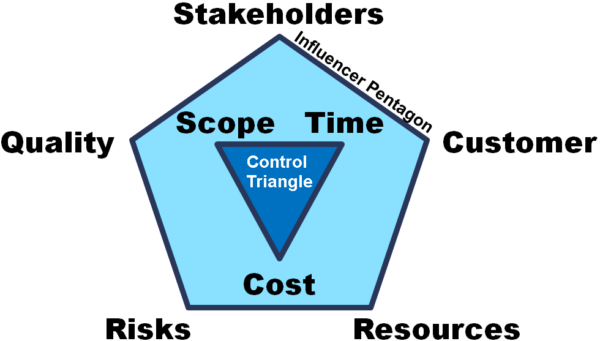Articles & Events, IT
Project Management basics
Project management is not the entire operation of your company. It’s just one segment, a specified project with a detailed plan as to how you and your business are going to achieve a goal. It’s a plan detailed in a series of steps, each of them as important as the others. You must achieve one to properly move on to the next.
Think of project management as a ladder you wish to climb. You can’t leap to the top, you must take it rung by rung for utmost efficiency. Your team must apply the tools made available to them as well as their expertise and knowledge to execute each step before moving on to the next.
It’s easy enough to say you want to get to point A, top of the hill, (Scope) so you’re going to take 20 steps in a direction.
However you must get there by Sunday also factor (Time) considerations into your project plan, and you have $$$ to spend getting there (Budget). You might crawl those 20 steps or you might run. It depends on how quickly you must get there for successful completion of the project. You can save money by traveling on foot, or you can hire a driver. It depends on the budget you’ve dedicated to the project.
There is no one-size-fits-all approach, system, or plan. Each project you and your company tackle will most likely have its timeline, goal /scope and budget, the cost.
That’s why it’s so critical to have a savvy, talented project manager in place to run the show.
A successful project manager must simultaneously manage three basic elements of a project. These elements are interrelated, whilst managing the stakeholders (identify & meet with stakeholders, stakeholder is anyone who is affected by the results of your project plan internal and external or indeed is needed by you to implement), including of course the customer:
- Scope: This involves the project’s size, goals, and requirements.
- Time: This doesn’t just address how much time the project will take overall. It must be broken down into task duration’s, dependencies, and critical path.
- Budget: Have a firm grasp on costs (materials and resources, contingencies, and returns and profit (the reason for doing the project).

The Most Important Element is the Scope: The project scope is the definition of what the project is supposed to accomplish and the budgets of time and money that have been created to achieve the scope.
Any change to the scope of the project must have a matching change in budget, time, resources, or all three.
If the project scope is to construct a garage to house three cars on a budget of $100,000, the project manager is expected to do that. If the scope is changed build a hanger to house four planes, the project manager must obtain an appropriate change request in time, money, and resources.
Time: The three elements of successful time management are tasks, schedule, and critical path.
Build the project schedule by listing, in order, all the tasks that must be completed. Some must be done sequentially while others can overlap or be done in tandem. Assign a duration to each task. Allocate the required resources. Determine predecessors—what tasks must be completed before others—and successors, the tasks that can’t start until after each other task is completed.
Project management software can simplify the task of creating and managing the project schedule. Some tasks have a little flexibility in their required start and finish dates. This is called “float.” Other tasks have no flexibility. They have zero float. A line through all the tasks with zero float is called the critical path. All tasks on this path—and there can be multiple, parallel paths ( so beware)—must be completed on time if the project is to come in by its deadline. The project manager’s key time management task is monitoring the critical path. This is vital as is risk and issue management . We have run projects just on risk management alone and won awards . Do contact us if you need advice. This is the best thing you may ever learm and master.
Budget: The three considerations in managing budget are costs, contingencies, returns and profit. Each task has a cost, whether that’s the labour hours of a computer programmer or the purchase price of a cubic yard of concrete. Each of these costs is estimated and totalled when preparing the project budget.
Some estimates will be more accurate than others. The project budget should, therefore, include contingency allowances—money set aside in the budget “just in case” the actual cost of an item is wildly different from the estimate. PMI suggest you should have a project contingency which you as a Project Manager manage and a management contingency above which your manager or sponsor manages. 10% is common.
Results or Profit is the benefit the company wants to make from undertaking the tasks. It’s put on top of the cost.
So a project budget is composed of the estimated cost, plus the contingency, plus any quantifiable results and/or profit.
So the Project manager’s job is to keep the actual cost at or below the estimated cost and to maximize the profit and returns the company or organisation earns on the project.
Remember every project must have a measurable benefit.
Every project must have a clear brief, objectives, scope of work, deliverables, timelines cost, and responsibilities,
Good luck!
